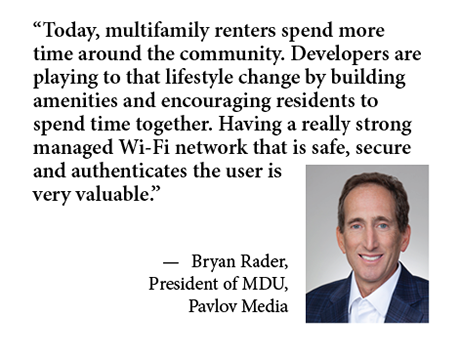Multifamily residents want to take their internet connections with them beyond their unit’s four walls and throughout the complex.
The National Multifamily Housing Council has found for years that 90 percent of renters say good internet access is a necessity. But the meaning of good connectivity has changed.
“Ten, fifteen or twenty years ago, the most popular trend was cocooning — where people would go to work, come home and run into their apartment. They’d close the door, and you wouldn’t hear or see from them again until the next day,” says Bryan Rader, president of MDU at internet service provider Pavlov Media.
“Today, multifamily renters spend more time around the community,” he continues. “Developers are playing to that lifestyle change by building amenities and encouraging residents to spend time together. Having a really strong managed Wi-Fi network that is safe, secure and authenticates the user is very valuable.”
Put more simply, Wi-Fi within amenities is important to renters. Take fitness centers, for example. When was the last time you saw anyone on a treadmill without headphones relaying music from the internet through a phone or tablet?
The move toward property-wide internet demand started in universities as students needed internet across their many mobile devices. Then the schools expanded technology use in teaching. Students now need wireless connectivity everywhere they go: where they live, where they eat, where they have class, where they study. “What we’ve seen in the last five years is that what started as a student-centric solution works well for all multifamily,” says Rader.
“New multifamily construction is expanding the areas where residents can sit together and meet outside. They have walking spaces, pet areas and parks, volleyball courts and pickleball.” Increasingly, renters work from home at least some of the time rather than always commuting for a fixed on-site shift. They want to use some of this amenity space as a third workspace — separate from their home or office.
So many consumers have developed the habit of being online everywhere they go, and the result is resident expectations for ubiquitous wireless online access across multifamily properties.
To remain competitive, multifamily properties need property-wide Wi-Fi, and that means managed internet service that bridges connectivity within a unit and across the entire property. The property-wide blanket of internet access cannot be as fast or as practical if one provider is offering connectivity across the property’s grounds while a mix of service providers operate in the apartment units. Competing connections and signals interrupt the seamless experience residents expect.
Beyond what residents want, managed internet access across the entire property also addresses the needs of the owners and operators. “Owners are looking for ways to be more efficient in how they manage their property,” says Rader. Remote systems can manage temperature, lights and access for vacant units. Internet of things (IoT) devices also help with remote showing, ultimately leading to faster turnover and less lost revenue, increasing efficiency. “Managed Wi-Fi can allow you to reduce some of your staff on the property as well,” says Rader.
Implementing managed internet and Wi-Fi service is common in new construction. “It’s much easier, mechanically, to build from scratch, design things properly, and have and build all the right infrastructure,” Rader explains. “The percentage using managed Wi-Fi is probably over 90 percent of multifamily communities today; it’s that significant.”
Moving to property-wide connectivity becomes more complicated when discussing a retrofit of an existing multifamily property. Buildings from the 1980s or 90s are more likely to have older styles of network cabling or coaxial cable, none of which can support the necessary internet traffic. They might not have dropped ceilings, which would more easily allow wiring modifications versus opening walls to install fiber optic cable.
“Installing fiber through walls is expensive to do — it’s not easy, it’s disruptive and you need access to every apartment and to every amenity space,” Rader says. “Furthermore, you’ve got to install hardware; you have to educate every resident. And yet the apartment ownership groups in the industry are all saying, ‘Yes, it’s an issue, but we still need managed Wi-Fi in those communities.’ We believe that 2023 has become the inflection point.”
For existing multifamily locations, owners will want to look to more experienced providers who can navigate the challenges involved to gain the promised benefits and meet the ever-growing expectations of residents.
— This article was written in conjunction with Pavlov Media, a content partner of REBusinessOnline. For more information on Pavlov Media, click here.


